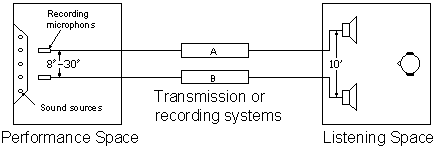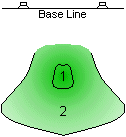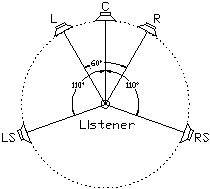
Multichannel Audio

| System | N1 | P1 | N3 | P2 | N4 |
| Mono | 1 | - | 1 | Y | 1 |
| Surround Mono | 1 | - | 1 | may be | >=1 |
| Incomplete Stereo | 2 | Y | 1 | Y | 2 |
| Regular Stereo | 2 | - | 2 | - | 2 |
| Enhanced Stereo | 4 | Y | 2 | Y | 4 |
| Regular Quadraphonic | 4 | - | 4 | - | 4 |
Stereo Systems
Mono system does not provide many characteristics of the performance space to the listeners.
These characteristics include perception of the volume (spatial perception), localization of different sound
sources, the reverberation process and many others.

A stereo system is illustrated in the figure above. Such system provides or improves the followings: the special perception, localization of the virtual sound sources (located between the two loudspeakers), perceptions of the sound field of the performance space, and the frequency characteristics of the reproduced sound sources.
Stereo-Sound Listening Area
All the characteristics that are described in the stereo reproducing sound will depend largely on the
position of the listeners with respect to the loudspeakers.
The following illustration shows the
optimum area for stereo listening. Area 1 represents the listening locations where the
preference of the stereo system compared with the mono system is more than 85%. In
this area the listener can locate all of the virtual sources of the sound stage along the
line between the loudspeakers.

When the listener moves farther off the line of symmetry, the virtual sound sources move
toward the closest loudspeaker as well and the width of the reproduced sound stage reduced.
Consequently, the preferences of the stereo system drop. The listening area where the
preference is 60-85% represents the location where the listener can separate fewer
virtual sound sources (at least 3 groups) on the loudspeakers line (Base Line).
The stereo-effect area can be increased in many ways. One way is to minimize the shifting of the
location of the reproduced sound stage when the listener moves off the symmetry line. This can be done
in different ways, one of which is to aim the loudspeakers as following:

Multichannel Audio Systems
Multichannel systems refer to the system that incorporate more than two loudspeakers as well as two or more transmission channels
or recording processes. These systems are widely used in the movie/home theaters.
The major issue for these systems is the compatibility between different types for different applications as well as
the compatibility with the regular stereo or mono system. This is the reason why these systems were standardized not long time ago.
The main configuration of the system for home theaters is the 5-1 or 3-2 system illustrated
in the following drawing. This configuration can be used with different transmission
systems or recording processes and it is independent of the coding formats.

Practically, room interiors may not be optimized for the loudspeaker layout, and
movement of some loudspeaker is needed. In this case, delay of some loudspeaker signals will be needed.

The central front loudspeaker is usually supplied by the sound of the vocalist, soloist, or
dialogue. The front right and left loudspeakers are for stereo reproduction. The
ambiance/surround sound is supplied to the surround loudspeakers. A subwoofer is used
for low frequency signals that may be processed from an independent channel in the transmitted
or recorded system. There are few formats used in the industry for the coding applied
in preproduction and postproduction of the channel signals (Dolby Digital and
others).
Many other different electronic and acoustical details should be implemented to achieve the desired
listening experience with this system. These details include:
---the low frequency response of the loudspeakers is 80 Hz (with uniform polar response in defined angles)
---the sound pressure level at the listening position from each loudspeaker is 82 dBC measured with pink noise (signal with wide frequency spectrum)
---the subwoofer signal filtering has cut off frequency less than 150 Hz.
---smooth low frequency output from the subwoofer.
This last point may require real time measurements and optimizing the shape and the finishing
of the listening room and the location of the subwoofer.